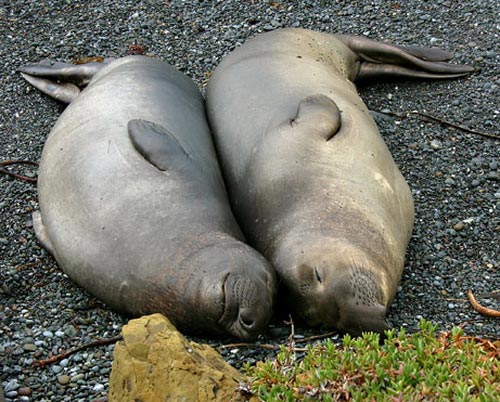Elephant seals 'sleep' during dive
A new study explains how the elephant seals scientists ask for a long time when they leave the mainland during the 8-month migration season in the sea.

An afternoon nap of the elephant seals on San Simon Beach, California
Whales and dolphins are believed to be able to fall asleep at the sea surface when half of their brains rest, while the other half works normally but the northern elephant seal (Mirounga angustirostris) does not sleep. such.
To find the answer, scientists observed the elephant seal migration season from California waters to feed around Alaska and the middle of the Pacific.
A team of American and Japanese explorers appropriately selected six northern elephant seals while young from elephant seals at Ano Nuevo, California, USA to wear a modern electronic card to collect data, observing them during migration such as speed, depth, temperature, position and three-dimensional movement of elephant seals.
The results of the study show that their sleeping behavior is strange, their backs curl and their body movements in a spiral slowly towards the bottom of the sea and this action is repeated many times throughout the season. immigrant.
Researcher Russell Andrews works at the University of Alaska Fairbanks (USA), a research team member, author of this article published in the Royal Society's Journal of Biology, said: 'The process is swaying, leaning. The body cyclic when they drop in the water slowly down to the ocean is like the movement of a yellow leaf falling from the branches to the ground. They perform 'sleep' to rest, relax during long periods of migration and perhaps help digest their food easily. The depth that they plunged into the seabed is also different, more than 800m for males and 600m for females . '
The elephant seal experienced 250-300 days of sea migration and the distance they took the migration journey amounted to 21,000km.
- Elephant seals help study the Antarctic bottom
- California seals change in bulk because of seawater pollution of mercury
- Seals only sleep with half a brain
- Scientists discovered the least sleeping animal
- The secret to pre-existing natural danger of hat seals
- The largest animals on the planet
- How does the seal maintain oxygen when diving?
- Seeing the mini version yourself, seals do surprises
- 7,000 Russian seals are in danger of being destroyed
- Great discoveries about giant elephants
- Seals stray between forests in Sweden
- Seals of film production in the United States
 Surprised: Fish that live in the dark ocean still see colors
Surprised: Fish that live in the dark ocean still see colors Japan suddenly caught the creature that caused the earthquake in the legend
Japan suddenly caught the creature that caused the earthquake in the legend A series of gray whale carcasses washed ashore on California's coast
A series of gray whale carcasses washed ashore on California's coast Compare the size of shark species in the world
Compare the size of shark species in the world